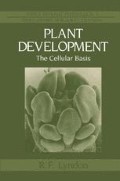Abstract
The existence of patterns of cells, tissues, and organs implies coordination of the development of the units making up the patterns. There are basically two types of pattern-forming process. The order may be the result of an assemblage of similar but independent units like tiles, each with its own pattern, pushed together on a board. Alternatively, the pattern may be because of interaction between developing units, which promote or inhibit each others development and so modify the pattern as it forms (differentiation-dependent pattern formation). Are all patterns in plants formed interactively and, if so, what is the nature of the interactions between cells, tissues, and organs, and how do they control plant form?
Access this chapter
Tax calculation will be finalised at checkout
Purchases are for personal use only
Preview
Unable to display preview. Download preview PDF.
Further Reading
Barlow, P. W. & D. J. Carr (eds) 1984. Positional controls in plant development. Cambridge: Cambridge University Press.
Davies, P. J. (ed.) 1987. Plant hormones and their role in plant growth and development. Dordrecht: Martinas Nijhoff.
French, V., P. J. Bryant & S. V. Bryant 1976. Pattern regulation in epimorphic fields. Science 193, 969–81. (Polar coordinate model of positional information)
Gunning, B. E. S. & A. W. Robards (eds) 1976. Intercellular communication in plants: studies on plasmodesmata. Berlin: Springer.
Hepler, P. K. & R. O. Wayne 1985. Calcium and plant development. Annual Review of Plant Physiology 36, 397–439.
Lindenmayer, A. 1982. Developmental algorithms: lineage versus interactive control mechanisms. InDevelopmental order: its origin and regulation, S. Subtelny & P. B. Green (eds), 219–45. New York: Alan R. Liss.
Meinhardt, H. 1984. Models of pattern formation and their application to plant development. InPositional controls in plant development, P. W. Barlow & D. J. Carr (eds), 1–32. Cambridge: Cambridge University Press.
Sachs, T. 1984. Controls of cell patterns in plants. In Pattern formation: a primer in developmental biology, G. M. Malacinski (ed.), 367–91. New York: MacMillan.
Author information
Authors and Affiliations
Rights and permissions
Copyright information
© 1990 R. F. Lyndon
About this chapter
Cite this chapter
Lyndon, R.F. (1990). Pattern formation, positional information, and integration of growth. In: Plant Development. Topics in Plant Physiology, vol 3. Springer, Dordrecht. https://doi.org/10.1007/978-94-011-6844-1_12
Download citation
DOI: https://doi.org/10.1007/978-94-011-6844-1_12
Publisher Name: Springer, Dordrecht
Print ISBN: 978-94-011-6846-5
Online ISBN: 978-94-011-6844-1
eBook Packages: Springer Book Archive

